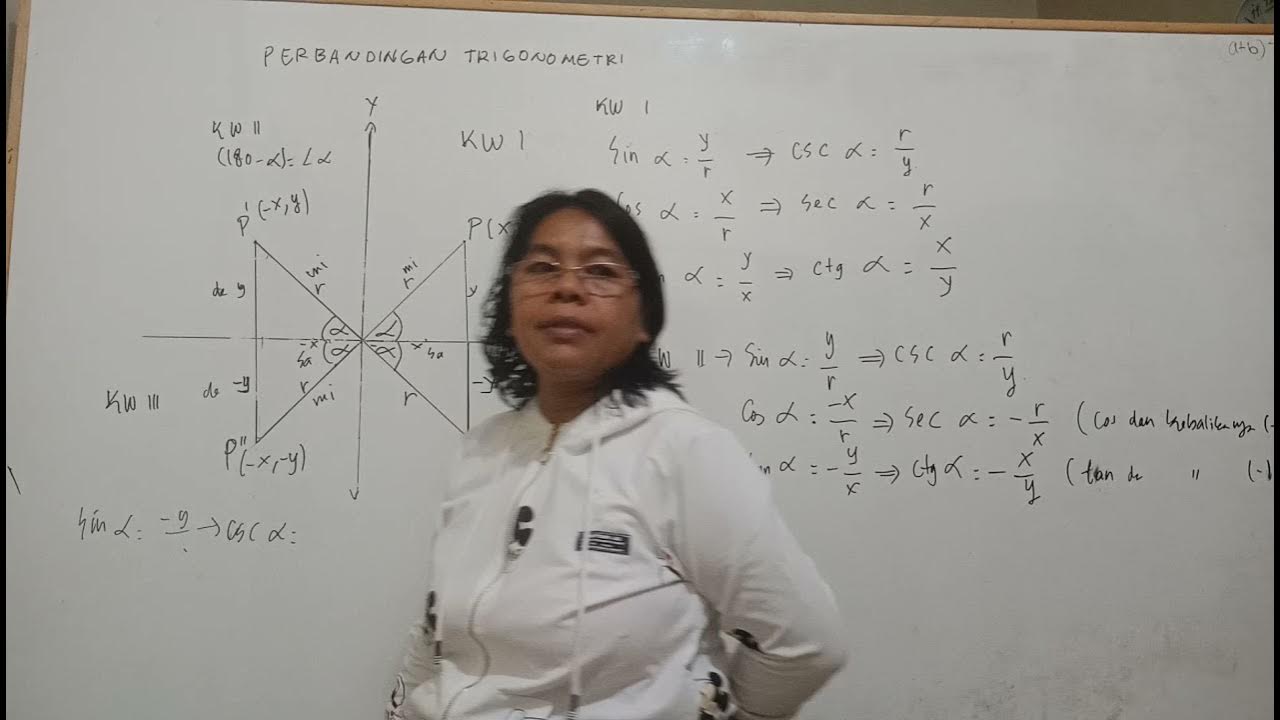Limits of Trigonometric Functions
Summary
TLDRThis video covers examples of evaluating limits involving trigonometric functions. It explains the limit of sin(x)/x as x approaches 0, confirming that it equals 1, and also examines the limit of (1 - cos(x))/x, which equals 0. The video provides step-by-step solutions for problems involving limits like sin(5x)/x, sin(2x)/5x, and tan(4x)/3x, showing methods of substitution and simplification. It also discusses more complex cases involving expressions with sine squared and tangent functions. Through these examples, viewers gain a deeper understanding of limits with trigonometric functions.
Takeaways
- 📉 The limit as x approaches 0 of sin(x)/x equals 1, and this can be verified by plugging in values close to 0.
- 🔢 The limit as x approaches 0 of (1 - cos(x))/x equals 0, and smaller values of x will yield closer results to zero.
- ✍️ To solve the limit of sin(5x)/x as x approaches 0, you multiply the numerator and denominator by 5 and use substitution (y = 5x).
- 🧠 The limit of sin(2x)/(5x) as x approaches 0 equals 2/5, which can be quickly seen or solved through substitution.
- ➗ The limit of sin(7x)/sin(3x) as x approaches 0 equals 7/3, which can be derived by multiplying and substituting.
- ☑️ The limit of tan(x)/x as x approaches 0 equals 1, which can be simplified using trigonometric identities.
- 💡 The limit of tan(4x)/(3x) as x approaches 0 equals 4/3 by converting tan(x) into sin(x)/cos(x) and using substitution.
- 🧮 The limit of 7 * (1 - cos(x))/x as x approaches 0 equals 0 since the (1 - cos(x))/x term approaches 0.
- 📝 For the limit of sin^2(x)/x as x approaches 0, the answer is 0 since sin(x)/x approaches 1 but multiplying by 0 results in 0.
- 📊 The limit of sin(x^2)/x as x approaches 0 is also 0, which can be solved by substitution and splitting the expression into separate limits.
Q & A
What is the limit as x approaches 0 of sin(x)/x?
-The limit as x approaches 0 of sin(x)/x is 1. This can be confirmed by evaluating values close to 0, such as sin(0.1)/0.1, which is approximately 0.998, and sin(0.01)/0.01, which is approximately 0.99998.
What is the limit as x approaches 0 of (1 - cos(x))/x?
-The limit as x approaches 0 of (1 - cos(x))/x is 0. As you substitute values closer to 0, the result gets closer to 0, such as (1 - cos(0.1))/0.1 ≈ 0.05 and (1 - cos(0.01))/0.01 ≈ 0.005.
How can you solve the limit as x approaches 0 of sin(5x)/x?
-To solve this limit, multiply both the numerator and denominator by 5, transforming the expression into (sin(5x)/(5x)) * 5. Substituting y = 5x, this becomes sin(y)/y * 5, where the limit as y approaches 0 of sin(y)/y is 1. Thus, the result is 5.
What is the limit as x approaches 0 of sin(2x)/(5x)?
-The limit is 2/5. By multiplying both the numerator and denominator by 2/2 and substituting y = 2x, the expression becomes (sin(y)/y) * (2/5), and the limit as y approaches 0 of sin(y)/y is 1. Thus, the result is 2/5.
What is the limit as x approaches 0 of sin(7x)/sin(3x)?
-The limit is 7/3. By multiplying the numerator and denominator by the necessary constants, the expression simplifies to (sin(7x)/(7x)) * (3x/sin(3x)) * (7/3), and using known limits of sin(y)/y, the result is 7/3.
How do you evaluate the limit as x approaches 0 of tan(x)/x?
-Rewrite tan(x) as sin(x)/cos(x), so the expression becomes (sin(x)/x) * (1/cos(x)). The limit of sin(x)/x as x approaches 0 is 1, and cos(0) = 1, so the result is 1.
What is the limit as x approaches 0 of tan(4x)/(3x)?
-The limit is 4/3. By expressing tan(4x) as sin(4x)/cos(4x) and multiplying by 4/4, the expression simplifies to (sin(4x)/(4x)) * (4/3), and using the limit sin(y)/y as 1, the result is 4/3.
What is the limit as x approaches 0 of 7 * (1 - cos(x))/x?
-The limit is 0. Since the limit as x approaches 0 of (1 - cos(x))/x is 0, multiplying by 7 results in 7 * 0 = 0.
How do you solve the limit as x approaches 0 of sin²(x)/x?
-Rewrite sin²(x) as sin(x) * sin(x), then the expression becomes (sin(x)/x) * sin(x). As x approaches 0, sin(x)/x approaches 1, and sin(0) is 0, so the result is 1 * 0 = 0.
What is the limit as x approaches 0 of sin(x²)/x?
-First, multiply both the numerator and denominator by x, giving (sin(x²)/(x²)) * x. Substituting y = x², the expression becomes sin(y)/y * x, where the limit of sin(y)/y is 1, and x approaches 0, so the result is 0.
Outlines

Esta sección está disponible solo para usuarios con suscripción. Por favor, mejora tu plan para acceder a esta parte.
Mejorar ahoraMindmap

Esta sección está disponible solo para usuarios con suscripción. Por favor, mejora tu plan para acceder a esta parte.
Mejorar ahoraKeywords

Esta sección está disponible solo para usuarios con suscripción. Por favor, mejora tu plan para acceder a esta parte.
Mejorar ahoraHighlights

Esta sección está disponible solo para usuarios con suscripción. Por favor, mejora tu plan para acceder a esta parte.
Mejorar ahoraTranscripts

Esta sección está disponible solo para usuarios con suscripción. Por favor, mejora tu plan para acceder a esta parte.
Mejorar ahoraVer Más Videos Relacionados

1.4 Limit Fungsi Trigonometri

✅INTEGRALES trigonométricas con POTENCIAS [𝙚𝙣 4 𝙋𝙖𝙨𝙤𝙨 😎🫵💯 ] Cálculo Integral

Perbandingan Trigonometri

Section 6.2 - Trig integrals and substitution - Part 1

ECUACIONES TRIGONOMETRICAS

Limit Fungsi Trigonometri Matematika Kelas 12 • Part 1: Konsep dan Penurunan / Pembuktian Rumus
5.0 / 5 (0 votes)
